Ying Tan
Repetitive Contrastive Learning Enhances Mamba's Selectivity in Time Series Prediction
Apr 12, 2025Abstract:Long sequence prediction is a key challenge in time series forecasting. While Mamba-based models have shown strong performance due to their sequence selection capabilities, they still struggle with insufficient focus on critical time steps and incomplete noise suppression, caused by limited selective abilities. To address this, we introduce Repetitive Contrastive Learning (RCL), a token-level contrastive pretraining framework aimed at enhancing Mamba's selective capabilities. RCL pretrains a single Mamba block to strengthen its selective abilities and then transfers these pretrained parameters to initialize Mamba blocks in various backbone models, improving their temporal prediction performance. RCL uses sequence augmentation with Gaussian noise and applies inter-sequence and intra-sequence contrastive learning to help the Mamba module prioritize information-rich time steps while ignoring noisy ones. Extensive experiments show that RCL consistently boosts the performance of backbone models, surpassing existing methods and achieving state-of-the-art results. Additionally, we propose two metrics to quantify Mamba's selective capabilities, providing theoretical, qualitative, and quantitative evidence for the improvements brought by RCL.
Exploring Interference between Concurrent Skin Stretches
Mar 26, 2025Abstract:Proprioception is essential for coordinating human movements and enhancing the performance of assistive robotic devices. Skin stretch feedback, which closely aligns with natural proprioception mechanisms, presents a promising method for conveying proprioceptive information. To better understand the impact of interference on skin stretch perception, we conducted a user study with 30 participants that evaluated the effect of two simultaneous skin stretches on user perception. We observed that when participants experience simultaneous skin stretch stimuli, a masking effect occurs which deteriorates perception performance in the collocated skin stretch configurations. However, the perceived workload stays the same. These findings show that interference can affect the perception of skin stretch such that multi-channel skin stretch feedback designs should avoid locating modules in close proximity.
Hierarchical Information-Guided Spatio-Temporal Mamba for Stock Time Series Forecasting
Mar 14, 2025Abstract:Mamba has demonstrated excellent performance in various time series forecasting tasks due to its superior selection mechanism. Nevertheless, conventional Mamba-based models encounter significant challenges in accurately predicting stock time series, as they fail to adequately capture both the overarching market dynamics and the intricate interdependencies among individual stocks. To overcome these constraints, we introduce the Hierarchical Information-Guided Spatio-Temporal Mamba (HIGSTM) framework. HIGSTM introduces Index-Guided Frequency Filtering Decomposition to extract commonality and specificity from time series. The model architecture features a meticulously designed hierarchical framework that systematically captures both temporal dynamic patterns and global static relationships within the stock market. Furthermore, we propose an Information-Guided Mamba that integrates macro informations into the sequence selection process, thereby facilitating more market-conscious decision-making. Comprehensive experimental evaluations conducted on the CSI500, CSI800 and CSI1000 datasets demonstrate that HIGSTM achieves state-of-the-art performance.
A GPU Implementation of Multi-Guiding Spark Fireworks Algorithm for Efficient Black-Box Neural Network Optimization
Jan 07, 2025Abstract:Swarm intelligence optimization algorithms have gained significant attention due to their ability to solve complex optimization problems. However, the efficiency of optimization in large-scale problems limits the use of related methods. This paper presents a GPU-accelerated version of the Multi-Guiding Spark Fireworks Algorithm (MGFWA), which significantly improves the computational efficiency compared to its traditional CPU-based counterpart. We benchmark the GPU-MGFWA on several neural network black-box optimization problems and demonstrate its superior performance in terms of both speed and solution quality. By leveraging the parallel processing power of modern GPUs, the proposed GPU-MGFWA results in faster convergence and reduced computation time for large-scale optimization tasks. The proposed implementation offers a promising approach to accelerate swarm intelligence algorithms, making them more suitable for real-time applications and large-scale industrial problems. Source code is released at https://github.com/mxxxr/MGFWA.
Online 4D Ultrasound-Guided Robotic Tracking Enables 3D Ultrasound Localisation Microscopy with Large Tissue Displacements
Sep 17, 2024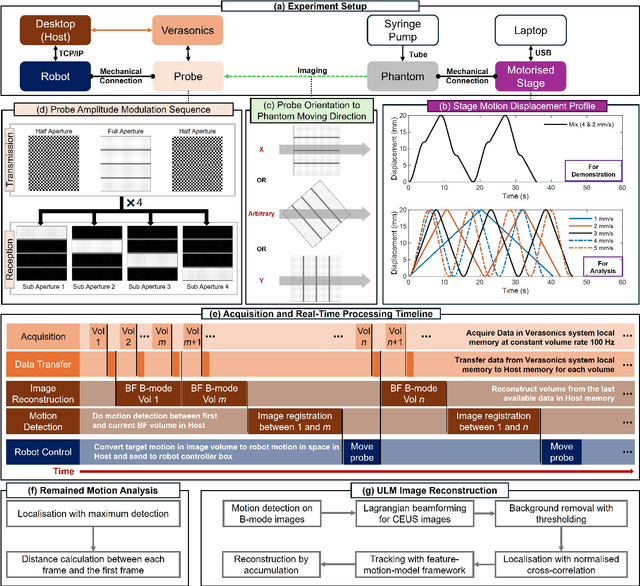
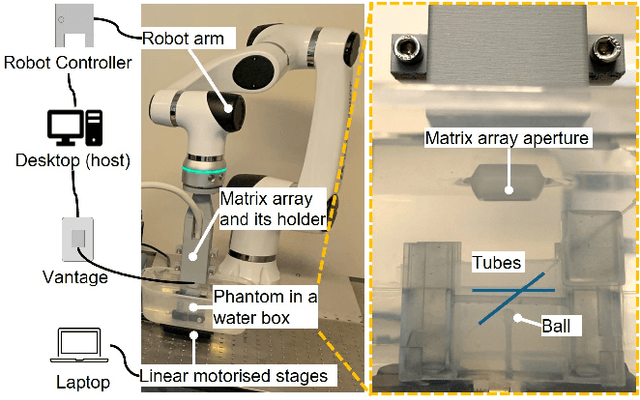
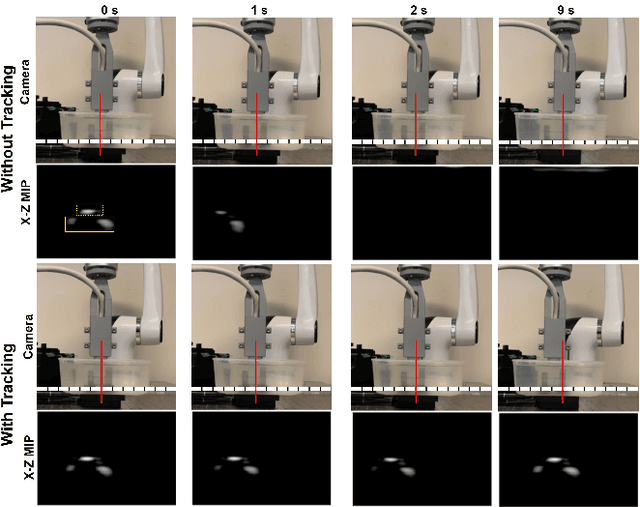

Abstract:Super-Resolution Ultrasound (SRUS) imaging through localising and tracking microbubbles, also known as Ultrasound Localisation Microscopy (ULM), has demonstrated significant potential for reconstructing microvasculature and flows with sub-diffraction resolution in clinical diagnostics. However, imaging organs with large tissue movements, such as those caused by respiration, presents substantial challenges. Existing methods often require breath holding to maintain accumulation accuracy, which limits data acquisition time and ULM image saturation. To improve image quality in the presence of large tissue movements, this study introduces an approach integrating high-frame-rate ultrasound with online precise robotic probe control. Tested on a microvasculature phantom with translation motions up to 20 mm, twice the aperture size of the matrix array used, our method achieved real-time tracking of the moving phantom and imaging volume rate at 85 Hz, keeping majority of the target volume in the imaging field of view. ULM images of the moving cross channels in the phantom were successfully reconstructed in post-processing, demonstrating the feasibility of super-resolution imaging under large tissue motions. This represents a significant step towards ULM imaging of organs with large motion.
Multi-SIGATnet: A multimodal schizophrenia MRI classification algorithm using sparse interaction mechanisms and graph attention networks
Aug 25, 2024



Abstract:Schizophrenia is a serious psychiatric disorder. Its pathogenesis is not completely clear, making it difficult to treat patients precisely. Because of the complicated non-Euclidean network structure of the human brain, learning critical information from brain networks remains difficult. To effectively capture the topological information of brain neural networks, a novel multimodal graph attention network based on sparse interaction mechanism (Multi-SIGATnet) was proposed for SZ classification was proposed for SZ classification. Firstly, structural and functional information were fused into multimodal data to obtain more comprehensive and abundant features for patients with SZ. Subsequently, a sparse interaction mechanism was proposed to effectively extract salient features and enhance the feature representation capability. By enhancing the strong connections and weakening the weak connections between feature information based on an asymmetric convolutional network, high-order interactive features were captured. Moreover, sparse learning strategies were designed to filter out redundant connections to improve model performance. Finally, local and global features were updated in accordance with the topological features and connection weight constraints of the higher-order brain network, the features being projected to the classification target space for disorder classification. The effectiveness of the model is verified on the Center for Biomedical Research Excellence (COBRE) and University of California Los Angeles (UCLA) datasets, achieving 81.9\% and 75.8\% average accuracy, respectively, 4.6\% and 5.5\% higher than the graph attention network (GAT) method. Experiments showed that the Multi-SIGATnet method exhibited good performance in identifying SZ.
TCGPN: Temporal-Correlation Graph Pre-trained Network for Stock Forecasting
Jul 26, 2024Abstract:Recently, the incorporation of both temporal features and the correlation across time series has become an effective approach in time series prediction. Spatio-Temporal Graph Neural Networks (STGNNs) demonstrate good performance on many Temporal-correlation Forecasting Problem. However, when applied to tasks lacking periodicity, such as stock data prediction, the effectiveness and robustness of STGNNs are found to be unsatisfactory. And STGNNs are limited by memory savings so that cannot handle problems with a large number of nodes. In this paper, we propose a novel approach called the Temporal-Correlation Graph Pre-trained Network (TCGPN) to address these limitations. TCGPN utilize Temporal-correlation fusion encoder to get a mixed representation and pre-training method with carefully designed temporal and correlation pre-training tasks. Entire structure is independent of the number and order of nodes, so better results can be obtained through various data enhancements. And memory consumption during training can be significantly reduced through multiple sampling. Experiments are conducted on real stock market data sets CSI300 and CSI500 that exhibit minimal periodicity. We fine-tune a simple MLP in downstream tasks and achieve state-of-the-art results, validating the capability to capture more robust temporal correlation patterns.
Derivative-Free Optimization for Low-Rank Adaptation in Large Language Models
Mar 04, 2024
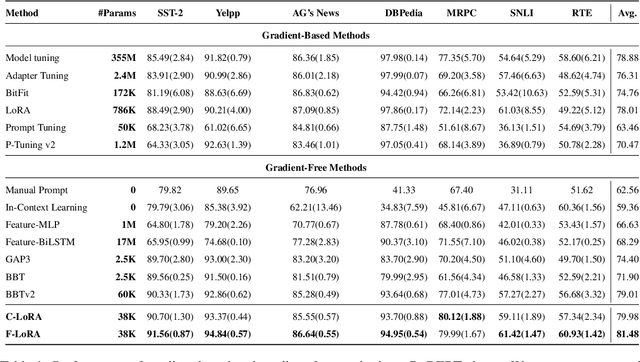

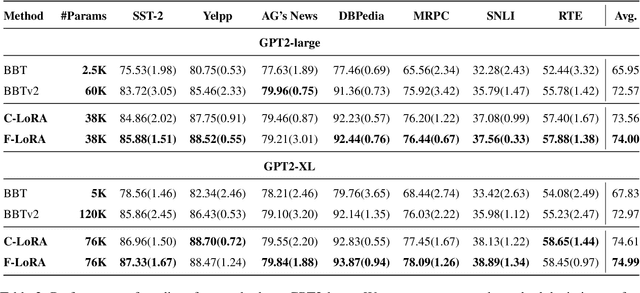
Abstract:Parameter-efficient tuning methods such as LoRA could achieve comparable performance to model tuning by tuning a small portion of the parameters. However, substantial computational resources are still required, as this process involves calculating gradients and performing back-propagation throughout the model. Much effort has recently been devoted to utilizing the derivative-free optimization method to eschew the computation of gradients and showcase an augmented level of robustness in few-shot settings. In this paper, we prepend the low-rank modules into each self-attention layer of the model and employ two derivative-free optimization methods to optimize these low-rank modules at each layer alternately. Extensive results on various tasks and language models demonstrate that our proposed method achieves substantial improvement and exhibits clear advantages in memory usage and convergence speed compared to existing gradient-based parameter-efficient tuning and derivative-free optimization methods in few-shot settings.
Zero-Shot Chain-of-Thought Reasoning Guided by Evolutionary Algorithms in Large Language Models
Feb 08, 2024Abstract:Large Language Models (LLMs) have demonstrated remarkable performance across diverse tasks and exhibited impressive reasoning abilities by applying zero-shot Chain-of-Thought (CoT) prompting. However, due to the evolving nature of sentence prefixes during the pre-training phase, existing zero-shot CoT prompting methods that employ identical CoT prompting across all task instances may not be optimal. In this paper, we introduce a novel zero-shot prompting method that leverages evolutionary algorithms to generate diverse promptings for LLMs dynamically. Our approach involves initializing two CoT promptings, performing evolutionary operations based on LLMs to create a varied set, and utilizing the LLMs to select a suitable CoT prompting for a given problem. Additionally, a rewriting operation, guided by the selected CoT prompting, enhances the understanding of the LLMs about the problem. Extensive experiments conducted across ten reasoning datasets demonstrate the superior performance of our proposed method compared to current zero-shot CoT prompting methods on GPT-3.5-turbo and GPT-4. Moreover, in-depth analytical experiments underscore the adaptability and effectiveness of our method in various reasoning tasks.
Data-Driven Goal Recognition in Transhumeral Prostheses Using Process Mining Techniques
Sep 15, 2023Abstract:A transhumeral prosthesis restores missing anatomical segments below the shoulder, including the hand. Active prostheses utilize real-valued, continuous sensor data to recognize patient target poses, or goals, and proactively move the artificial limb. Previous studies have examined how well the data collected in stationary poses, without considering the time steps, can help discriminate the goals. In this case study paper, we focus on using time series data from surface electromyography electrodes and kinematic sensors to sequentially recognize patients' goals. Our approach involves transforming the data into discrete events and training an existing process mining-based goal recognition system. Results from data collected in a virtual reality setting with ten subjects demonstrate the effectiveness of our proposed goal recognition approach, which achieves significantly better precision and recall than the state-of-the-art machine learning techniques and is less confident when wrong, which is beneficial when approximating smoother movements of prostheses.
 Add to Chrome
Add to Chrome Add to Firefox
Add to Firefox Add to Edge
Add to Edge